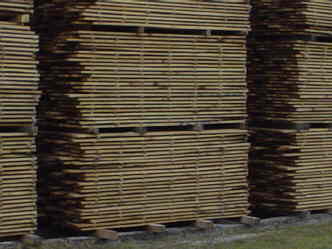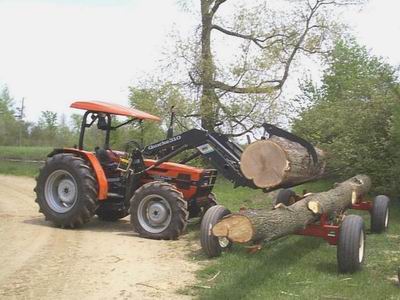Stacking and Stickering Advice for Air-Drying Maple
A thorough discussion of the basics of stacking sawn lumber for air-drying. February 14, 2010
Question
I currently do not have stickers, as this will be my first attempt at cutting lumber. What is the best material to use? I have some old particleboard, 1/2" thick in 4'x4' sheets and was going to cut strips and combine two strips together to give me a thickness of 3/4"-1". Would this work?
I have also considered using Styrofoam sheeting and cutting this into long strips, because it can be purchased cheaply and used over and over again. Will this work?
I am from southwest PA and will hopefully have about 500 bf of cherry and maple by the end of this weekend. Will it hurt to air dry this for a while? I plan on properly stacking it, 12-18" off the ground on cinder blocks, and covering the tops. I will place this pile in my backyard, covered by trees. It will get the morning sun for a few hours and then be protected from direct sunlight by the trees. I will also cover the top of the pile with a sheet of plywood with weights on top of that. I plan on stacking it the very best I can. Will the hot temperatures, and possibly humidity, cause a lot of damage to the wood? I have heard that maple will stain. Should I not cut maple this time of year for air drying? Also, do you recommend painting the board ends?
Forum Responses
(Sawing and Drying Forum)
From Professor Gene Wengert, forum technical advisor:
We need the stickers to be made of a material that will withstand weathering and weight. Both products you mention will not perform well in this situation. Most people use solid wood. In a pinch, you can use 1x2 lath from a building supply dealer.
From contributor P:
Maple is tricky. When I used solid hardwood stickers I stacked it for a few days and then restacked it, moving the stickers slightly to avoid stain. I now use stickers that I made having a cross section of that, similar to an I beam. No problems now. I typically air dry for several months (covered) to a year before either kiln drying to 6% or selling as air dried to about 11 to 12 %.
From contributor S:
Make your pile where it gets the most wind possible. Put your stickers 2" from each end and evenly spaced in between. Buy s4s pine and rip it 1" wide for stickers.
From contributor T:
You're right - maple can be tricky to dry in warm weather. Better to do it in cold weather. The cherry is more forgiving and good handling practices should yield good results. Check with your local lumberyards for broken stickers. They sometimes use 6' stickers and broken 6' stickers can, with selection, yield good 4' pieces.
Watch that the tarp doesn't lie directly on top of the stack. That could cause it to trap water next to the lumber. Put down a top layer of stickers, then the plywood, then more stickers and a couple of sacrificial boards before placing the tarp over top of everything.
From contributor C:
You are higher than necessary off the ground, but it can't hurt. Maybe put the cinder blocks on top and 6x6 bolsters of old beams underneath. Be sure to use enough cinder blocks so that they are spaced no more than about 2', and that your stickers are above them so that the weight doesn't press down between blocks. It should be fairly level, because the planks will take on the shape you give it. Don't use particleboard - it will swell, and 1/2" is not enough for best airflow. Styrofoam will compress. 500 bd ft of green cherry will weigh about 2500 lbs, maybe a bit more. I use 4 sheets of plywood on top of a 4' x 10' stack, at a gentle slope to shed rain, and overlapped so that I get some overhang - with pier blocks on top.
From Professor Gene Wengert, forum technical advisor:
Although 12" to 18" off the ground is good, the key is to have this space open so that the wet, cool air that sinks down can escape easily. I have seen the cement "parking lot bumpers" used and they lift the lumber but also block the air flow; they are not good. It is the opening that is the key.
Here is a good article on stain causes and cures that will help you prevent staining:
Causes and Cures for Stains in Dried Lumber
From contributor S:
If you are sawing cherry, make some sticks from the low grade center of the log. Just saw some 4/4 boards, stand them up on edge on the mill and saw 3/4" strips. I usually run 3-4 boards at a time doing this. Use a radial arm or chop saw to cut the sticks to the length you need.
I've started to make platforms to pile my lumber on. I use junky 2x8's or whatever thicker lumber I can round up and then nail them to 4x4's. I put these on the ground or on blocks and then a layer of sticks and then the lumber pile. Having a real solid base helps keep problems from occurring later on. Get some sheet metal roofing or some rubber roofing for the top.
Being under your trees is okay for this summer, but you may want to find a drier location later if the pile is going to be around for a while.
From contributor G:
Won't using green stickers result in sticker stain?
From Professor Gene Wengert, forum technical advisor:
For maple, dry stickers are essential. Also, fast drying (not under a tree) is essential if you want the white color. For cherry, some staining is indeed tolerable, but it is still best to avoid staining conditions (wet stickers, slow drying in warm weather).
It is often well to remember that the wood you are drying is perhaps worth (when dry) about $2 per BF or $2000 per MBF. It therefore makes sense to use expensive stickers (that you can use several times in the future), as the overall cost is under $20 per MBF. In other words, the sticker cost is a small portion of the overall cost and assures a good profit. Stain or color loss on a few pieces will exceed $20 loss.
From contributor A:
If nothing else, go to the store and buy some 2x4's and rip them into strips. They are about the cheapest wood and 10 footers will make you 18 3/4x1x40" stickers. You can go to construction sites and pick up scraps and make them from the junk leftover. Foam and OSB do not make good stickers.

From the original questioner:
Thank you for helping me out with this issue. After reading everything, I will be using the top quality stickers. If the wood begins to stain, is this something that can be planed off, or does it go completely through the wood? Does anyone recommend a coating to put on the ends of their logs?
From contributor R:
Yes, I'm sure most of the posters would recommend end coating the logs as soon after cutting to length as possible. I use a coating from Bailey's, a sawmill and logging supplier.
From Professor Gene Wengert, forum technical advisor:
Some stain can be planed off, but most stain goes too deep for planing off. AnchorSeal (company name is UC Coatings) is one of the most popular end coatings.
From contributor C:
I use Anchor Seal, and Baileys is similar. Those are the two that are almost always referred to. Some will say paint is good enough, but not usually. At any rate, whatever you put on needs to go on ASAP. Most of the end check damage will happen in as little as a few days, greatly reducing the effect of end seal.
From contributor S:
If you want to minimize stain in your maple, leave the trees standing until after November, then get it cut, stacked and the air drying process started in the winter. Even with the best efforts you can still get sticker shadow. Most commercial operations like to get summer cut maple into the kiln right away. Cherry heartwood doesn't stain, even if it's deadpiled over the summer.
From Professor Gene Wengert, forum technical advisor:
Sticker shadow can be 100% prevented if you dry the lumber correctly and if the logs are fresh. Read the report on stain causes and cures at the link above.
From contributor N:
I cut them like contributor A, only around 10 to 12 boards at a time. You can make a pile of stickers in a hurry. I cut them well ahead of time so they're dry when using them.
From contributor H:
All my stickers are kiln dried, and remain dry when not used. When stickering white wood we use basswood sticks. Never use green cut sticks - wet spots leave stain.

